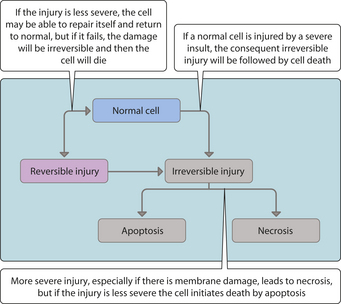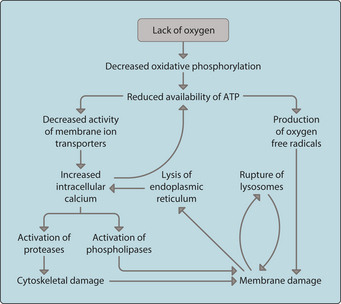Chapter 9 Causes of cell injury
There is a wide variety of agents that can cause cell damage. Whatever the cause, if the injury is relatively minor the cell may be able to repair itself and return to normal. This is reversible injury; it may be characterized morphologically at the light microscopic level by cellular swelling (called hydropic change or vacuolar degeneration) or by fatty change, and at the ultrastructural level by blebbing of the cell membrane, abnormalities of mitochondria and endoplasmic reticulum, and disaggregation of nuclear structures. However, if the initial insult to the cell is severe or prolonged, an irreversible injury will occur and the cell will die by apoptosis or necrosis. The factors that determine which pathway is followed are complex and not entirely understood but it seems that damage to cell membranes promotes death by necrosis rather than apoptosis. These pathways are illustrated in Fig. 3.9.1 (see also Ch. 10).
Hypoxia
In clinical practice, cell damage caused by reduced oxygen supply is usually a consequence of reduced blood flow (ischaemia). A zone of necrosis caused by ischaemia is an infarct. The pathways involved in hypoxic cell damage are summarized in Fig. 3.9.2. The initiating factor is reduced availability of energy in the form of ATP, which causes the ion pumps to fail and the metabolic processes of the cell to increase production of reactive oxygen species. The latter directly damage cell components such as membranes, while the failure of ion pumps causes activation of proteases and phospholipases as the concentration of calcium within the cell rises. As the integrity of membranes breaks down, more calcium is released from the endoplasmic reticulum, and digestive enzymes are released from lysosomes. Cell death occurs by necrosis or apoptosis, depending on the severity of the injury. Cerebral neurons die after only a few minutes if the blood supply is cut off; other cells survive longer (e.g. liver cells can last an hour or two).
< div class='tao-gold-member'>
Stay updated, free articles. Join our Telegram channel

Full access? Get Clinical Tree








